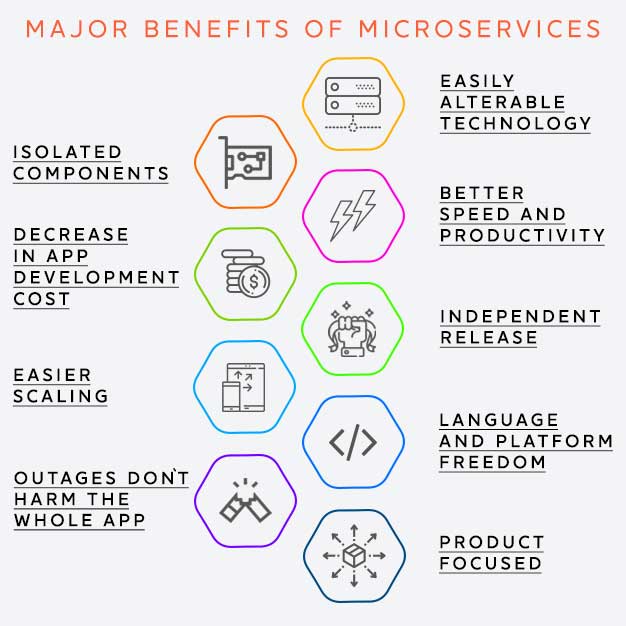All You Need to Know About Using Micorservices in Mobile Apps
Success in the world of mobile apps can be ephemeral if a business doesn’t keep up with times. Given the fierce competition and race to emulate with the latest trends, an app is celebrated on one day and labelled outdated on the other. Sometimes, a business has invested years in building and testing an app product making it what it is, so much so that it gets difficult to re-do it from scratch. Even if you are dealing with an app which is a hit among users, the architecture can be too big for a developer to fully comprehend. There can be changes in market trends that can suddenly break your product, making it outdated or worse, irrelevant. A mobile app business which intends to keep up with the times is required to be agile. It is expected to adapt to the changes happening in the market and retain the ‘cutting edge’ badge.
Adoption of the latest lean development practices without opting for the risk and cost that is associated with re-platforming involves developing a strategic plan of action. Embracing microservices lets you work on a serverless architecture and provides you with desirable perks like agility and scalability.
What are Microservices?
Microservices are an app architectural style. It allows one to develop an app as a suite of small services. The idea is to de-construct business processes into simpler functions. Instead of building monolithic applications, developers build a series of components that make up the app. The components are stitched together using common APIs.
The distinct advantage of choosing Microservices is that in case of failure, they streamline UX from discrete atomic units. Microservices are an architectural design pattern that thrives on cloud technology and cloud platform. Microservices work in close harmony in a larger system to execute tasks that can be handled by a single app built on the monolithic style of architecture. They communicate with each other through remote procedure calls (RPCs).
Microservices can be used to design/redesign all kinds of applications. If you have an app that is based on monolithic architecture, you can break up the system of your app in instalments and replace it with microservices gradually. Every microservice has a smaller code base, which is easier to understand. Microservices are a simplified substitute to monolithic architecture for modular mobile application development.
Essential Components of a Microservices Architecture
The components that make up a winning Microservices architecture very depending on the scale and business requirement of an application.
API Gateway
API Gateway serves as a point of entry for the defined group of microservices. A client needs to call API gateway, which forwards the call to the specific services on the back end. A distinct benefit of using API gateways is that they allow app developers to encapsulate the internal structure of an application in multiple ways, depending upon the use case.
Database
Microservices can choose between sharing the same database or having independent databases.
Benefits of Microservices
I. Isolated Components- The distinct advantage of using microservices architecture to build a mobile app is that it allows developers to build loosely-coupled services. They can be further developed, modified, and scaled individually. This also guarantees fault isolation, i:e any fault in a microservice would not lead to a fault in other microservices of the application.
II. Easily Alterable Technology- Given the isolated nature of microservices, the technology stack can be altered without interfering with one another. App developers can opt for different technology stacks for each microservice. This particular architecture enables decoupled services written in different programming languages to exist together as a single application.
III. Product Focused- Working with microservices allows app developers to focus on product building instead of worrying about the project. The team of app developers can emphasize on developing business functionalities when working with microservices architecture. This also omits the need to write a code from scratch. The same microservice can be reused in multiple applications.
IV. Better Speed and Productivity- As the application is developed in multiple parts as microservices, the breakdown helps overcome the problem of speed and productivity. Different teams of developers can work on different components of the app without facing any delays due to fellow teams. It is for this reason that opting to make an app with microservices architecture enhances overall project productivity. Developers can work autonomously and make the required changes independently.
V. Easier Scaling- All components of a mobile app are characterised by different needs. While certain functionalities would eat up more of the memory space, others will need more database access, third-party services, better network bandwidth or even more computational resources. Opting for the microservices architecture ensures that each component gets an appropriate environment to thrive in, with an option to scale if and when required. Unlike monolithic architecture, microservices architecture doesn’t require the entire application to be scaled up. Easily availability of infrastructure with clouds enables developers to scale just the process that is experiencing the surge. With an option for each service to scale independently, developers are free to choose hardware that is best suited for the particular service’s resource requirement.
VI. Independent Release- Microservices allow different components to run the whole system. Say there is a team of 100 developers, they can be lined up in groups of 10, each working on a different app component. This makes it possible for an app business to initiate independent releases and deployment of components. Meaning each service of the component can develop in quick succession to market’s needs, be tested and deployed soon after. A business can test smaller bits if code and also cut down on relapse cycle spans. This is time-saving when compared to what happens in the case of monolithic apps.
VII. Outages Don’t Harm the Whole App- As we have established, microservices are developed and deployed independently. This makes them better at management of mobile apps in case of outages. It doesn’t result in shut down of working of the app as a whole. Microservices allow the application to automatically react to control the damage, without letting it show on app functionality.
VIII. Language and Platform Freedom- With microservices, you choose the liberty to narrow down on the best of OS, languages, libraries and runtimes for a particular app. The basic requirement is that each service has a well-defined interface that works in harmony with other services. While in applications built on monolithic architecture; it is a norm to share a single database with other services, ones built on microservices architecture pattern use a separate database for each service. This helps loose coupling.
IX. Decrease in App Development Cost- Most businesses dread changes to monolithic applications which mean costly and time-consuming redevelopment, testing and redeployment of server-side code. On the other hand, look at a microservice app as a set of modules of code that are built and deployed as independent entities and are reusable. Let your developer complement the Microservice architecture with UI which is converted into a modular purpose-built component. Following a service-based approach to develop application architecture saves one copy of application logic for capability. This is completely regardless of the number of applications leveraging from that particular logic. In the long run, this approach decreases the cost of development and helps you reach your customers faster.
Conclusion
Renowned applications like Amazon, Twitter, Netflix and Uber among many more swear by the Microservices Architecture Pattern. It is clearly the best mobile architecture type for complex and evolving applications. The architecture type eases scalping up of the app both vertically and horizontally. That said, not all apps will benefit from a microservices architecture. The basic criteria to settle for microservices architecture is that the app has to be complex enough that it can be broken into a number of different components. A simple app with a single or couple of functions doesn’t need microservices. Another important thing to keep in mind is to decide which functions of an application need to be broken down into components. Please note that components that need to share data or transfer data can actually slow down an app based on the microservices style of architecture.
Whether you opt for Microservices architecture from the scratch or transitioning from a monolithic model to microservices, the set of challenges you face depend on the type of application you have and the dexterity of your development team. We recommend that you do not chuck the old version of the software outrightly. Instead, work on the new microservices version simultaneously as you keep the old one afloat. Our team of developers at Promatics can help you transit into a Microservices based app, smoothly.
Still have your concerns?
Your concerns are legit, and we know how to deal with them. Hook us up for a discussion, no strings attached, and we will show how we can add value to your operations!

